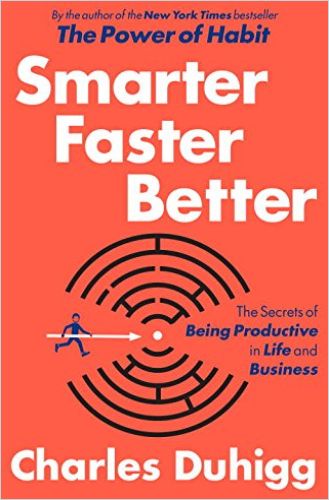Pulitzer Prize-winning New York Times reporter Charles Duhigg, best-selling author of The Power of Habit, is an engaging writer with a compelling roster of stories.

Compelling Stories
Charles Duhigg offers intriguing stories to demonstrate creative problem solving, though he doesn’t always immediately tie his anecdotes to their teaching points. Instead, he saves advice for his detailed appendix, “A Reader’s Guide to Using These Ideas,” which offers brief take-aways for applying the lessons in his narratives.
While the stories don’t offer immediate guidance, as you might anticipate from The Power of Habit, they do provide fascinating reading. Duhigg is an exceptional nonfiction writer with a rare understanding of suspense, pace and structure. Each chapter functions as a stand-alone story or a gathering of related stories. Duhigg’s dramatic approach will please readers who enjoy tales of counterintuitive solutions and disasters avoided or handled intelligently. To give this book context, read Duhigg’s The Power of Habit, and for more great stories with useful insights, Malcolm Gladwell’s books are also worthwhile companion reads.
Counterexamples
Duhigg details how people performed highly specific tasks in some smarter, better or faster way by relying on their training, intuition, courage, ability to detect their own judgment errors and refusal to succumb to fear. Or, he recounts how they absolutely failed to do so and points out what they could have done differently. Each negative example comes with a real-world positive counterexample.
Many current business books seem to draw on the same storehouse of innovative solution-finders. Duhigg visits that storehouse, too, with his account of how the writers and producers of Frozen thought their way out of self-created roadblocks. But even if Pixar’s and Disney’s methods suffer from some business book overexposure, the author offers an intriguing visit behind the scenes.
I’ve spoken to the filmmakers behind Disney’s “Frozen,” and learned how they made one of the most successful movies in history under crushing time pressure – and narrowly averted disaster – by fostering a certain kind of creative tension within their ranks.Charles Duhigg
Duhigg’s saga of the origins of the Saturday Night Live (SNL) television show works because of his appreciation for insider anecdotes about weird, funny or eccentric behavior. For example, misanthropic comedy writer Michael O’Donoghue wrote a TV-commercial parody containing language that ensured it could never be seen on-air. Michaels, demonstrating his singular genius for keeping sensitive performers happy, had the actors read O’Donoghue’s parody “at 18 different rehearsals” so his work got plenty of laughs and attention without being aired. And Donoghue got what he desired – respect and admiration from his peers. Michael’s genius was in knowing what the writer truly wanted, just as Duhigg often makes you consider what you genuinely hope to derive from fulfilling a goal.
Google and Teamwork
Duhigg finds valuable nuggets in exploring Google’s process of self-examination. He takes you through Google’s arduous attempts to learn why some teams work and others don’t. It found that successful teams demonstrate high social sensitivity. Members discern each other’s emotions based on their speech, body language and facial expressions.
Data scientists at Google and writers from the early seasons of “Saturday Night Live”…said both organizations were successful, in part, because they abided by a similar set of unwritten rules regarding mutual support and risk taking.Charles Duhigg
Duhigg reports Google’s findings that effective teams abide by certain norms. First, team members know their work matters and find their efforts purposeful. These teams define their objectives clearly and assign members specific responsibilities. The members trust and rely on one another, and they feel psychologically safe, a result largely of how their team leaders behave.
To avoid creating an “interrupting norm,” which damages team cohesion, Duhigg cautions that team leaders should never interrupt anyone. After members speak, leaders should repeat their crucial points to demonstrate attentive listening. The author defines further duties for team leaders: if they can’t answer a question or don’t know about an issue, they must say so. They must make sure every person has a chance to speak and no one dominates. And, he says, leaders must urge members to express their irritations while they recognize and resolve any internal disputes.
“Stretch Goals”
Duhigg advises combining SMART – specific, measurable, achievable, realistic and timed – goals with stretch goals, defined in the journal of the Academy of Management Review as “jolting events that disrupt complacency and promote new ways of thinking.”
To set and achieve stretch goals, establish a “Goal-Setting Flowchart” as the antidote to a to-do list. Crossing off easily achieved tasks on a to-do list may give you an uplift, Duhigg explains, but it doesn’t enhance your productivity. And checking off “buy milk” doesn’t bring you any closer to fulfilling a truly SMART goal. For real accomplishment, link both kinds of goals on your goal-setting flowchart.
Productivity, put simply, is the name we give our attempts to figure out the best uses of our energy, intellect and time…a process of learning how to succeed with less stress and struggle.Charles Duhigg
Duhigg delineates six sensible steps for tracking a goal from definition to fulfillment. First, identify your stretch goal, say, running a marathon. Second, distinguish a “specific sub-goal,” such working up to running seven miles without a rest. Third, set your metric for success, such as running “twice around the park, no walking.” Fourth, make sure you can achieve this metric. Can you run your laps three times weekly? Fifth, make sure your sub-goal and metric are realistic. Here, Duhigg furnishes a reality check. For example, perhaps you really could run before work if you get up early three days a week. And last, specify your “timeline,” for example, how will you work progressively to run greater distances and take more frequent runs to build your endurance for a marathon? Or do you still want to?
Motivation
Duhigg candidly shares difficulties he experienced with self-confidence and motivation. Reporting for The New York Times, promoting his previous book and trying to be a good father and husband overwhelmed him. He found he mostly just wanted to sit in front of the television. He reveals that he changed his thinking by applying the principles that General Charles Krulak followed in his radical, successful revamping of the US Marine Corps’ boot camp, aimed at “strengthening recruits’ internal locus of control.”
The first step in creating drive is giving people opportunities to make choices that provide them with a sense of autonomy and self-determination.Charles Duhigg
The first principle Duhigg applied is that your motivation increases when a “chore” becomes a “choice.” When you are compelled to do something, you balk. But when you are empowered to select the task that comes next, you gain enthusiasm. The crucial mind-set shift happens when you move from having no choice in what you do to taking control over it. That sense of control spurs motivation and focus.
To make sure your motivation will endure, Duhigg advises, choose tasks that affirm your cherished objectives and personal values. To test whether each task meets that criterion, ask why you are taking an action before you carry it out. For example, why are you avoiding answering a particular email? Asking why reminds you that few tasks stand in isolation and asks you to make a conscious decision. Ideally, each chore you undertake brings you closer to completing a meaningful goal. If it doesn’t, ask why not?














